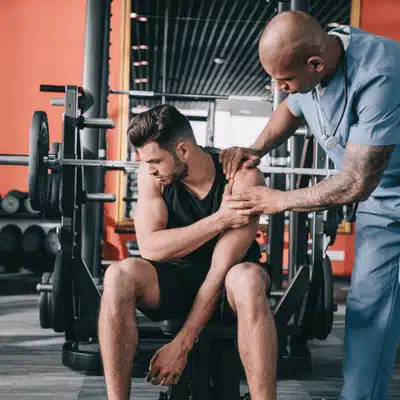
Shoulder pain affects millions of people each year. Most cases improve with rest and simple treatments. But some problems need surgery to restore function and relieve discomfort.
This article explains when surgery becomes necessary. You'll learn the warning signs to watch for and what conditions require an operation. We'll also cover how doctors perform an evaluation and what treatment options are available.

Shoulder pain has many causes. Overuse injuries from sports or work are common. Age-related wear and tear plays a role too. Sudden trauma like a fall can damage the joint.
Common shoulder problems include tendinitis, bursitis, and arthritis. Tendinitis happens when tendons become inflamed from repetitive motion. Bursitis occurs when the fluid-filled sac in your shoulder gets irritated. Osteoarthritis breaks down cartilage over time.
Most shoulder issues like tendinitis don't require shoulder surgery. Only a small number of patients need an operation. Many conditions improve with conservative treatment like rest, medications, and physical therapy.
But some problems are more serious. They may not respond to basic care. The question becomes whether your symptoms are severe enough to consider surgery.
Several symptoms suggest you may need shoulder surgery. Pay attention to these key indicators.
Pain that won't stop: If shoulder pain lasts for months without improvement, that's a warning sign. Pain that disrupts your sleep or daily activities signals a serious issue. When physical therapy and rest don't help after three to six months, surgery may be your best option.
Limited movement: Struggling to lift your arm or reach overhead indicates joint damage. Stiffness that prevents basic tasks like getting dressed suggests surgery might help. Loss of range of motion from frozen shoulder or advanced arthritis often causes this problem.
Frequent dislocations: Shoulders that pop out repeatedly need attention. Shoulder instability leads to more damage over time. If your joint feels unstable or you fear it will dislocate, you likely need surgical repair. Frequent dislocation creates shoulder instability that requires fixing.
Significant weakness: Loss of shoulder strength points to tendon damage. Rotator cuff tears often cause this symptom. Large tears require rotator cuff repair to restore function. If you can't lift objects or raise your arm, surgery may be necessary.
Advanced joint damage: Severe arthritis that causes bone-on-bone grinding needs treatment. When medications and injections stop working, shoulder replacement becomes an option. This surgery can dramatically reduce pain and improve motion.
Injuries that won't heal: A fracture or major ligament tear sometimes needs surgical fixing. Sports injuries that don't respond to care may require an operation. If you're not healing after months of treatment, surgery may be required.
Your age, health, and lifestyle also matter. If symptoms limit your work or hobbies significantly, that's another warning sign. The decision depends on how much your shoulder affects your quality of life.

Doctors ensure you've tried other treatments before recommending surgery. During a consultation, an orthopedic specialist checks your symptoms carefully. They perform an examination of your range of motion, strength, and any swelling.
Imaging tests help confirm the diagnosis. X-rays show bone problems like a fracture or arthritis. An MRI reveals soft tissue damage like rotator cuff tears or severe tendinitis. Ultrasound can show inflammation in tendons or bursa.
Most doctors recommend trying conservative treatment first. Common approaches include rest, physical therapy, medications, and injections.
Physical therapy strengthens your shoulder and improves flexibility. Exercise programs often resolve issues like shoulder impingement or mild tendinitis. Anti-inflammatory medications reduce pain and inflammation. A corticosteroid injection provides temporary relief by reducing swelling in cases of bursitis or tendinitis.
The goal is to achieve pain relief without surgery risks. These treatments succeed in many cases. Doctors have you continue this care until it's clear symptoms aren't improving. If you've tried everything for a reasonable period and still hurt, it's time to discuss surgery.
The type of operation depends on your specific problem. Shoulder surgeries range from minimally invasive repairs to full joint replacement.
Arthroscopy: Many issues can be fixed with arthroscopy. The surgeon makes small cuts and uses a tiny camera. This approach treats rotator cuff tears, tendinitis, and shoulder instability. For chronic bursitis or impingement, the surgeon removes inflamed tissue and shaves bone. This creates more space and reduces pain. Arthroscopy typically offers faster recovery than open procedures.
Open repairs: Some complex problems need traditional open surgery. Large fractures may require plates and screws. Extensive tendon tears sometimes need direct access through larger cuts.
Shoulder replacement: End-stage joint damage requires replacing the joint. Total shoulder replacement uses prosthetic parts for the ball and socket. This helps severe osteoarthritis or rheumatoid arthritis. For massive, irreparable tears with arthritis, a reverse replacement may be used. This design lets other muscles power your shoulder. Shoulder replacement has high success rates for pain relief. It's becoming more common as implants improve.
Most arthroscopy is outpatient while shoulder replacement may need a short hospital stay.
A simple timeline and risk checklist to help set realistic expectations.
Wear sling for comfort, begin gentle assisted movements, manage pain with medications.
Start physical therapy, gradually increase range of motion, wean off strong pain meds.
Resume daily activities, begin strengthening exercises, 80–90% recovered.
Continue improving strength, return to sports and heavy activities, full recovery.
All surgery carries risks. But the benefits can be life-changing when done for the right reasons.
Benefits: The main advantage is lasting pain relief. Many patients report their pain completely disappears. Surgery also restores function so you can raise your arm and regain strength. You'll likely need fewer pain medications afterward.
Risks: Complications can include infections, bleeding, or blood clots. Nerve or blood vessel injury may cause numbness or weakness. Some patients develop stiffness or scar tissue. For replacements, joints can dislocate or loosen over years. Rotator cuff repairs might not heal fully or could tear again.
Despite these risks, serious complications are rare. Most patients feel the improvement is worth it.
Recovery: Healing takes time. Arthroscopy has shorter recovery periods. After major repairs, your arm stays in a sling for weeks. Full recovery can take months.
Rehabilitation through physical therapy is critical. You'll start with gentle movements and progress to strengthening. It often takes several months to achieve the best outcome. Most patients resume daily activities within weeks but avoid heavy lifting for longer.
By three to four months, many people are mostly recovered. Full strength may continue improving for up to a year.

Deciding on shoulder surgery is personal. Consult with a trusted orthopedic surgeon about your treatment options. Surgery is usually your choice based on when pain becomes unbearable or stops you from living normally.
The good news is that techniques keep advancing. In 2025, surgeons use refined methods and better implants. Success rates are high for restoring shoulder function.
Feel free to get a second opinion if you're unsure about alternatives. Clear information about your condition helps you make an informed decision. Surgery is never the first step. It's considered after other treatments fail or when damage is significant.
Take action now. If you have persistent shoulder pain that won't improve, don't wait. Schedule an evaluation with an orthopedic specialist to discuss your options. Early diagnosis and proper care prevent further damage and get you back to your normal life faster.
Most doctors recommend at least three to six months of physical therapy and other treatments. If your symptoms don't improve during this period, it may be time to discuss surgery. Severe injuries causing sudden weakness may need earlier intervention.
Many patients experience significant pain relief after surgery. However, some people may still have mild discomfort or limited motion. Results depend on the severity of your condition and how well you follow your recovery plan.
The top reasons include rotator cuff tears that don't heal, severe arthritis causing bone-on-bone grinding, frequent shoulder dislocations, and fractures that won't heal properly. Sports injuries and chronic tendinitis that don't respond to treatment also lead to surgery.
Recovery time varies by procedure type. Arthroscopy patients often return to light activities within weeks. Major repairs like rotator cuff surgery or shoulder replacement require several months. Most people continue improving for up to a year after surgery.